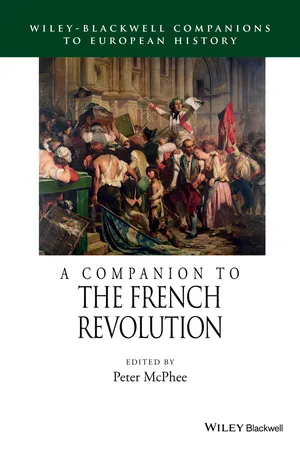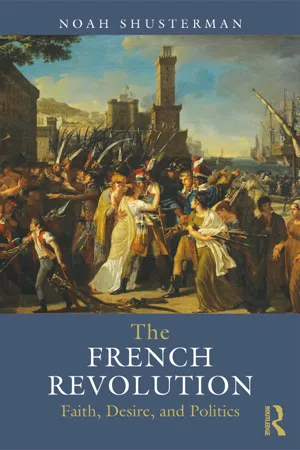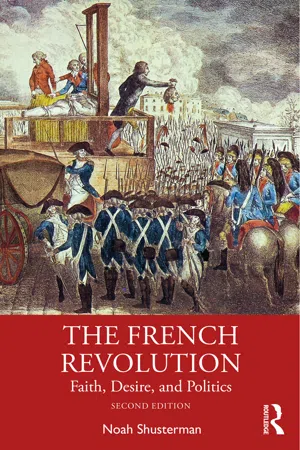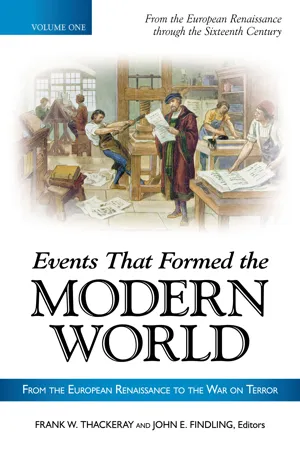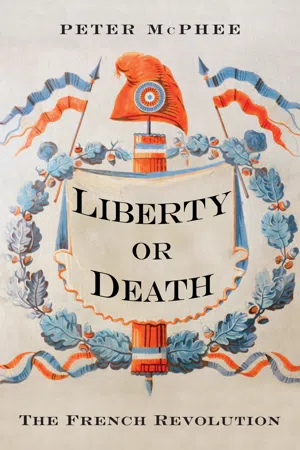History
Thermidorian Reaction
The Thermidorian Reaction refers to a period in the French Revolution following the fall of Robespierre in July 1794. It marked a shift away from the radical phase of the revolution, with the establishment of a more moderate government. The reaction led to the end of the Reign of Terror and the execution of many of its leaders.
Written by Perlego with AI-assistance
Related key terms
Related key terms
1 of 4
Related key terms
1 of 3
8 Key excerpts on "Thermidorian Reaction"
- eBook - ePub
- Peter McPhee, Peter McPhee(Authors)
- 2012(Publication Date)
- Wiley-Blackwell(Publisher)
PART VII
Searching for Stability, 1794–99
Passage contains an image
CHAPTER NINETEEN
The Thermidorian Reaction
LAURA MASONIn the final volume of his magisterial history of the French Revolution, Jules Michelet described Maximilien Robespierre’s defeat on 9 Thermidor II (27 July 1794) and the agonizing death that followed. Then he came to a full stop. “Breathe,” he counseled readers, “let us avert our eyes” (Mathiez 2010 [1929]: 7). Convinced that this fatal moment did not merely end the Terror but prepared a reversal of the Revolution’s greatest achievements, he would go no further. His successors advanced to take fuller measure of the Thermidorian Reaction, the fifteen months that separated Robespierre’s defeat from the Directory’s inauguration, but they shared Michelet’s conviction that here the Revolution doubled back on itself. So, for a century and more, historians confined themselves to debating the scope and merits of that reversal. Marxists like Albert Mathiez, Georges Lefebvre, and Albert Soboul agreed that the Reaction returned France to the liberal aspirations of 1789 and collectively regretted this repudiation of republican social revolution (Lefebvre 1964 [1957]; Mathiez 2010 [1929]; Soboul 1975 [1962]). The revisionist François Furet distinguished himself by extending the Reaction’s reach, to argue with Tocquevillian ambition that it resumed a centuries-long consolidation of the administrative state, and by celebrating Thermidor as a liberation, claiming that it freed civil society from the ideological servitude of the Terror (Furet 1981; Furet and Richet 1970). So fixed was the notion of reversal that no one offered a fundamentally new diagnosis until the late twentieth century, when the Polish philosopher Bronislaw Baczko argued that the Thermidorian Reaction did not reverse the Revolution but posed the complex question of how to end it (Baczko 1989, 1994). - eBook - ePub
- Jeremy D. Popkin(Author)
- 2019(Publication Date)
- Routledge(Publisher)
The thermidorian and Directory governments both claimed to be consolidating the essential achievements of the Revolution, while avoiding the excesses committed during the Reign of Terror. Liberty and equality were still official slogans, the government remained republican in form, and the revolutionary calendar, which glorified the Convention’s proclamation of the Republic in September 1792, remained in use. The post-thermidorian Republic carried on the war begun in 1792, kept up the struggle against the Catholic Church, and maintained the abolition of slavery in the colonies. The biggest difference in policy between this period and the one that preceded it was in the relationship between the government and the lower classes. Sobered by what they saw as the consequences of unlimited democracy, the thermidorians openly worked to establish a political regime dominated by the wealthy and educated. Only in this way, they believed, could social order be reconciled with a republican form of government.The Thermidorian Reaction
Initially it was not clear whether the Convention deputies who had overthrown Robespierre also meant to end the Terror. Many of the leading thermidorian conspirators, such as Fouché, one of the most prominent activists in the de-Christianization movement of 1793, and the deputy Tallien, who had publicly justified the September massacres and directed the repression of the federalist revolt in Bordeaux, had been active in the Terror. But thermidor unleashed a reaction against the Terror and the radical Revolution that soon escaped the plotters’ control. For the next five years, the question of how to repudiate the worst excesses committed in 1793–1794 without endangering the Revolution as a whole and all of those who had participated in the revolutionary government dominated French life.The thermidorian plotters quickly found themselves under pressure to dismantle the dictatorial apparatus of the Terror. The Committee of Public Safety’s powers were curtailed and thousands of prisoners arrested under the Law of Suspects were released from prison. Several of the most prominent architects of the Terror, including Carrier, who had overseen the massacres of rebels in Brittany, and Fouquier-Tinville, the prosecutor of the Revolutionary Tribunal, were tried and executed, despite their protests that they had simply carried out policies approved by the Convention as a whole. In November 1794, the Convention ordered the closing of the Paris Jacobin Club. In Paris, bands of elegantly dressed middle-class youths, the jeunesse dorée - eBook - ePub
The French Revolution
Faith, Desire and Politics
- Noah Shusterman(Author)
- 2013(Publication Date)
- Routledge(Publisher)
France’s military success made things easier on the government domestically – though not, it would seem, easy enough. France did not have to deal with another crisis along the lines of the fall of Verdun in 1792 or the breakout of civil war in 1793. After the violence of Germinal and Prairial III, French politics during these five years were stable if compared to the five preceding years, although that was a low bar to clear. But the government was never able to capture the enthusiasm of even a significant portion of the nation. The men who led the governments during this time were eager to avoid extremes. They did not want a return to monarchy; nor did they want a return to the Terror. In the aftermath of Robespierre’s fall, the character of Thermidorian politics began to take shape. This was a government committed to some form of republic, one that maintained many of the gains of the first years of the Revolution while hoping to avoid a repeat of the Terror. It remained far to the left of anything that had existed in the first few years of the Revolution. Even with the surviving Girondins reinstated, it was still a Convention dominated by men who were committed to the cause of republican France. It was also a Convention dominated by men who, in January 1793, had voted for the death of the king.Of all events from the first five years of the Revolution – from the fall of the Bastille to the fall of Robespierre, passing through the revolt of August 10, the September Massacres, the expulsion of the Girondins – it was the execution of Louis XVI that became the touchstone for political participation during Thermidor, what Furet called “the demarcation line between the sure and the unsure.”12 - eBook - ePub
The Afterlives of the Terror
Facing the Legacies of Mass Violence in Postrevolutionary France
- Ronen Steinberg(Author)
- 2019(Publication Date)
- Cornell University Press(Publisher)
If Thermidor marked the “ending of the Terror” rather than the end of the Terror—that is, a process rather than an event—it was to be an elusive ending. 135 This chapter situated this understanding of the Terror as a difficult past in a broad context, beyond the politics of the Thermidorian Reaction. Collective attitudes to mass violence and cataclysmic events have been changing in the transition from the early modern to the modern period. Secularization and the rise of the public sphere, among other processes of change, led to a view of catastrophes as political and social, rather than theological, events, and created new arenas of debate and contestation, where the effects of such events on the social order, as well as on individual psyches, could be discussed in relative freedom from the imposition of the state or the church. For its part, the French Revolution generated debates on the relationship between violence and the social order. The views of violence that emerged from these debates were ambivalent. Violence was seen as necessary for the creation of a new order, and at the same time, as having the potential to be its very undoing. After 9 Thermidor, this ambivalence rendered representations of the violence of the Terror problematic. Prudhomme’s work was an attempt to create an immediate history of this violence, but the textual topography of his book—its fragmentary nature—and the preoccupation with lists and classification, also suggested an inherent difficulty to read the social reality he purported to describe. The naming of the Terror as a difficult past would have profound implications on questions of accountability, redress, and remembrance in postrevolutionary France. - eBook - ePub
The French Revolution
Faith, Desire, and Politics
- Noah Shusterman(Author)
- 2020(Publication Date)
- Routledge(Publisher)
After the violence of Germinal and Prairial III, French politics during these five years were stable if compared to the five preceding years, although that was a low bar to clear. But the government was never able to capture the enthusiasm of even a significant portion of the nation. The men who led the governments during this time were eager to avoid extremes. They did not want a return to monarchy; nor did they want a return to the Terror. In the aftermath of Robespierre’s fall, the character of Thermidorian politics began to take shape. This was a government committed to some form of republic, one that maintained many of the gains of the first years of the Revolution while hoping to avoid a repeat of the Terror. It remained far to the left of anything that had existed in the first few years of the Revolution. Even with the surviving Girondins reinstated, it was still a Convention dominated by men who were committed to the cause of republican France. It was also a Convention dominated by men who, in January 1793, had voted for the death of the king. Of all events from the first five years of the Revolution—from the fall of the Bastille to the fall of Robespierre, passing through the revolt of August 10, the September Massacres, the expulsion of the Girondins—it was the execution of Louis XVI that became the touchstone for political participation during Thermidor, what Furet called “the demarcation line between the sure and the unsure.” 14 For the men in the government, their goal was to move the Revolution forward, preventing any return of the monarchy while emphasizing the protection of property and preventing the crowd from influencing politics as it had in earlier years. There was not, however, a stable or strong enough middle upon whose support the government could rely - eBook - ePub
Events That Formed the Modern World
From the European Renaissance through the War on Terror [5 volumes]
- Frank W. Thackeray, John E. Findling, Frank W. Thackeray, John E. Findling, Frank W. Thackeray, John E. Findling(Authors)
- 2012(Publication Date)
- ABC-CLIO(Publisher)
To guarantee that its policies were being implemented, the Committee of Public Safety dispatched specially empowered “representatives-on-mission” from Paris to the provinces and armies for the purpose of reviewing the actions of officials and generals. Failure to satisfy these deputies could precipitate the “swift, severe, and inflexible justice” of the guillotine. Ironically, the Revolution, which began as the most liberating movement in history, had now degenerated into the most pervasive and coercive dictatorship yet known.Although frequently criticized for its excesses, the Terror had significant positive results. All things considered, it achieved great success in surmounting the crises confronting France and saving the nation. By the end of 1793, foreign armies had been expelled from French territories and Republican armies had seized the offensive and carried the Revolution to other countries. Meanwhile, all internal rebellions were defeated or contained, and the economy was stabilized and organized for huge improvements in productivity. In the process, a surge of patriotic pride, passionate idealism, and selfless community spirit galvanized French society.Indeed, the dramatic success of the Terror led to the final power struggle among the more radical revolutionaries in the spring and summer of 1794. Maximilien Robespierre, the dominant figure on the Committee of Public Safety, purged moderates who desired an end to the Terror and radicals who wished to promote more socialist and egalitarian policies until his own ambitions and excesses precipitated his downfall and execution on July 27, 1794 (9 Thermidor according to the revolutionary calendar). The ensuing Thermidorian Reaction dismantled some of the measures and institutions of the Terror, while returning the First Republic to a moderate or even conservative course.During the Revolution’s last five years, the first theorist to espouse communism as later developed by Karl Marx and Vladimir Lenin appeared. He was François-Noel Babeuf, who called himself Gracchus in honor of the ancient Roman Republic’s reforming brothers; his plot to topple the government was called the Conspiracy of the Equals. Babeuf’s most influential idea called for the seizure of power in a coup d’état by a small, secretive, tightly knit, and well-organized band of dedicated revolutionaries, who would then impose a dictatorship on society until the uneducated popular masses could develop widespread appreciation of and support for their policies. Babeuf and his followers hoped to abolish private property and to distribute the necessities of life equally to all. Furthermore, the Babouvists devised innovative tactics: secret and separate cells of members, code-named agents, infiltration of enemy organizations, and subversion of military and civilian authorities. Their plans, however, were betrayed; Babeuf and his comrades were arrested in May 1796, and he was executed a year later. Yet his goals and methods would live on in the careers of future revolutionaries and the organizations they created. - eBook - ePub
Liberty or Death
The French Revolution
- Peter McPhee(Author)
- 2016(Publication Date)
- Yale University Press(Publisher)
CHAPTER FOURTEENSETTLING SCORESTHE THERMIDORIAN REACTION, 1794–95T HE THERMIDORIANS WERE HARDENED MEN WHO HAD LIVED through fifteen months of fearful apprehension, and they were determined that their experience would not be repeated.1 These men, the new majority in the Convention, were former Girondins, the ‘Plain’, and the anti-Robespierrist Jacobins. Their ‘Thermidorian regime’ in place from July 1794 was certainly republican, but driven above all else by the need to end the Revolution, most obviously by suppressing the sources of instability represented by the Jacobins and sans-culottes. In seeking to end revolutionary upheaval, they unleashed ferocious reaction against those blamed for the perceived excesses of what was now called ‘the Terror’, and a counter-reaction from those seeking to protect what had been won by sacrifice and virtue in 1793–94. It was a time of retribution, despair and some optimism for a settled future (Fig. 30 ).One of the first new members of the Committee of Public Safety was Jean-Lambert Tallien, among those most active in the overthrow of the Robespierrists, and under suspicion for having been too influenced in Bordeaux by his lover, the former noblewoman Thérésia Cabarrus. Tallien, when just twenty-six years old, had instigated with Claude-Alexandre Ysabeau a bloodily punitive repression of federalism in Bordeaux in August 1793, but now he appealed to the Convention one year later to dismantle all the evils of the Terror: ‘this was Robespierre’s system; he was the one who put it into practice with the help of a few subordinates.… The Convention was a victim of it, never an accomplice.’ Those who suggested that the Convention should take some responsibility were in fact guilty of sharing in the ‘monster’ Robespierre’s ‘infernal system’.2 Tallien arranged for the release of Cabarrus from prison; they married in December 1794 and Thérésia gave birth to a daughter, named Thermidor. Indeed, Thérésia herself was often called ‘Notre Dame de Thermidor’. Those closest to Robespierre, such as Rosalie Jullien, whose young son Jules had confronted Tallien in Bordeaux when an agent for the Committee of Public Safety, now had to appeal obsequiously to Cabarrus as a mother and a woman linked by ‘the natural sensitivity of our sex’ to secure Jules’ release from prison.3 - eBook - ePub
The Revolutionary Guards in Iranian Politics
Elites and Shifting Relations
- Bayram Sinkaya(Author)
- 2015(Publication Date)
- Routledge(Publisher)
The IRGC and politics in thermidorian Iran (1989–2005)Post-war Iranian politics entered profound change with the death of Ayatollah Khomeini in June 1989. In fact, after the end of the eight-year war with Iraq in July 1988, a wave of change had already swept Iran, generating a momentum that would restructure the Iranian economy and reformulate the fundamental bases of the Islamic Republic. At the end of the decade-long extremist policies of the radicals, it was extremely difficult for the Iranian government to chase ambitious revolutionary ideals. Therefore, ideological motivation behind previous revolutionary policies incrementally waned and became secondary to pragmatic and national interests. Thus, both the internal and the external policies of the Iranian government looked gradually more like the actions of a conventional state, indicating Iran’s ‘convalescence from the revolutionary fever’. In other words, the immense change in Iranian politics heralded the start of the ‘Iranian thermidor’. However, because the government continued to derive its legitimacy from the revolution, revolutionary impulses did not cease entirely, and they continued to dominate Iran’s national policies. 1 Therefore, the thermidor stage in Iran, resembling similar periods in other social revolutions, was marked with episodes illustrating the tension in Iran as it choose whether to be a revolutionary state or a conventional one. Understandably, this stage was marked with political instability and intense factional fighting.The sea change in Iran profoundly affected the Revolutionary Guards’ relationship to politics, as well. This chapter dedicated to analyzing the relations between the IRGC and the civilian political leadership in thermidorian Iran. In order to comprehend the IRGC–politics relationship, this chapter first reviews the political dynamics and the situation of the political elites in thermidorian Iran. Then, it analyzes the variables considered to be decisive when studying civil–military relations in revolutionary states and discusses the form of the IRGC–politics relationship in the new era. Finally, the chapter will analyze incidents occurring in Iran during the thermidorian stage (1989–2005) in order to comprehend the basis of the IRGC’s relationship to politics.
Index pages curate the most relevant extracts from our library of academic textbooks. They’ve been created using an in-house natural language model (NLM), each adding context and meaning to key research topics.
Explore more topic indexes
Explore more topic indexes
1 of 6
Explore more topic indexes
1 of 4
